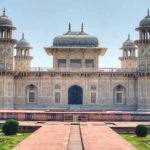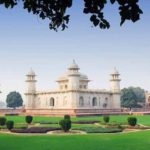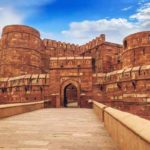Top 10 Monuments to see in Agra The Taj Mahal is India’s symbol, attracting millions of visitors every year to the city of Agra. This amazing landmark is as impressive as you can imagine. But while most travellers may be anxious to flee the pushy touts and overwhelming crowds of Agra as soon as they have left the Taj Mahal, you should think about sticking around a little longer.
Only one of many amazing places to visit in Agra is the Taj Mahal. You will visit the historically important Agra Fort while here; witness the impressively beautiful Itimad-ud-Daulah Tomb; see one of India’s largest mosques at Fatehpur Sikri; and find respite in Mehtab Bagh, a serene park in the Taj’s shadows.
Animal lovers, take note: Agra has two compassionate wildlife projects that invite visitors to learn about some of the most beloved animals in India (the Agra Bear Rescue Center and the Elephant Protection and Care Center).
Don’t let other tourists tell you that, apart from the Taj Mahal, there’s nothing to see in Agra. Plan your travel with our list of the top attractions in Agra to this heritage hot spot.
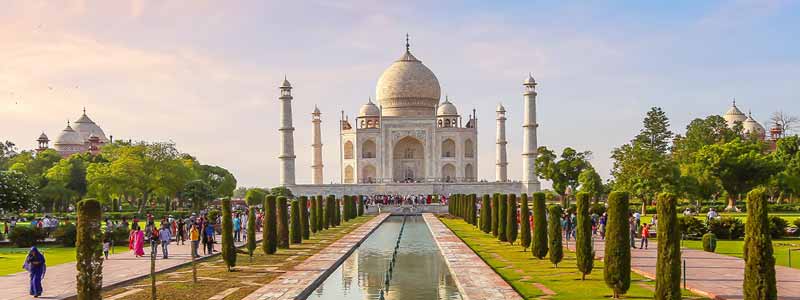
Taj Mahal: Perfect Showpiece Of Mughal Architecture
The Taj Mahal is a white marble mausoleum designed in 1631 by Emperor Shah Jahan for his second wife , Mumtaz Mahal. It is axiomatic to conclude that it is one of the greatest monuments to love ever created because of the storey behind its construction. Thousands of staff have been working on the building for over 20 years, embellishing it with excellent decorations, including white marble screens and semiprecious stone pietra dura inlay. The structure is the tallest Mughal tomb ever constructed, at over 200 feet (60 metres) tall, and is considered to be the single greatest piece of Mughal architecture. At the edge of the Yamuna River in Agra, it is the centrepiece of a sprawling complex of buildings, courtyards, gardens and waterways. This original landscape is mostly intact.
For its outstanding beauty and architectural value, the Taj has long been recognised and has been a UNESCO World Heritage Site since 1982. It is one of India’s national landmarks and every year it receives millions of tourists. This huge influx of tourists imperils the physical fabric of the monument, as with similarly famous, iconic, and fragile sites around the world. Moreover, although new industrial development has been banned in Agra and only non-polluting vehicles are permitted near the Taj, environmental pollution remains a major concern for the conservation of the mausoleum and its surrounding structures. In a landmark judgement in 1996, the Supreme Court of India ordered measures to conserve and secure the Agra ecosystem in order to safeguard the marble façade of the Taj Mahal. At the 1996 World Monuments Watch, the Taj Mahal was included to draw attention to the urgent need for a comprehensive plan for site management to establish a structure for ongoing maintenance, tourism management , protection, and improved site understanding. In the preamble to its judgement, the Court’s judgement cited World Monuments Watch, stressing international concern for the site.
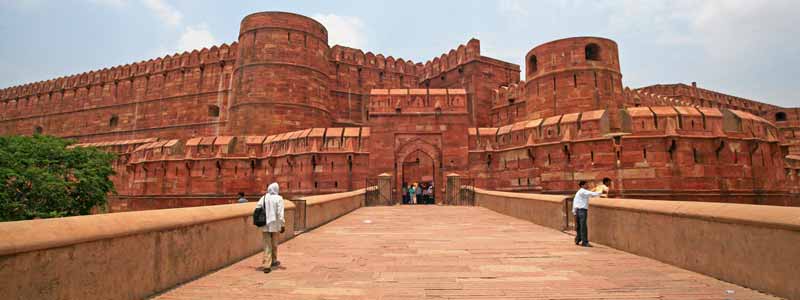
Agra Red Fort: The Main Fort
In the city of Agra in India, Agra Fort is a historical fort. Until 1638, when the capital was transferred from Agra to Delhi, it was the main residence of the emperors of the Mughal Dynasty. It is about 2.5 km northwest of its most prominent sister monument, the Taj Mahal. The Agra Fort is a UNESCO World Heritage site. As a walled city, the fort can be represented more accurately.
The triumphant Babur lived in the fort, in the palace of Ibrahim Lodi, after the First Battle of Panipat in 1526.In the city of Agra in India, Agra Fort is a historical fort. Until 1638, when the capital was transferred from Agra to Delhi, it was the main residence of the emperors of the Mughal Dynasty. It is about 2.5 km northwest of its most prominent sister monument, the Taj Mahal. The Agra Fort is a UNESCO World Heritage site. As a walled city, the fort can be represented more accurately.
The triumphant Babur lived in the fort, in the palace of Ibrahim Lodi, after the First Battle of Panipat in 1526. He built a Baoli in it later. In 1530, in the fort, his successor, Humayun, was crowned. He was defeated by Sher Shah Suri in 1540 at Bilgram. The fort stayed with the Suris until 1555, when it was recaptured by Humayun. The general of Adil Shah Suri, Hemu, recaptured Agra in 1556 and pursued its fleeing governor to Delhi, where in the Battle of Tughlaqabad he encountered the Mughals. Sheesh Mahal, Agra Fort: The effect created at Sheesh Mahal, Agra Fort, by lighting candles.
Akbar made it his capital, recognising the significance of its central condition, and arrived in 1558 in Agra. This was reported by his historian, Abul Fazl, as being a brick fort known as ‘Badalgarh.’ It was in a ruined state, and Akbar rebuilt it in Rajasthan with red sandstone from the Barauli region of Dhaulpur district. The foundation was laid by architects and it was constructed with bricks in the inner core and sandstone on external surfaces. For eight years, about 4,000 builders worked on it daily, finishing it in 1573.
It was only during the reign of the grandson of Akbar, Shah Jahan, that the site assumed its current status. In memory of his wife , Mumtaz Mahal, Shah Jahan constructed the beautiful Taj Mahal. Shah Jahan preferred to have buildings constructed from white marble, unlike his grandfather. To make his own, he demolished some of the earlier buildings inside the fort.
Shah Jahan was deposed at the end of his life and restrained in the fort by his uncle, Aurangzeb. It is rumoured that in Muasamman Burj, a tower with a marble balcony overlooking the Taj Mahal, Shah Jahan died.
In the early 18th century, the fort was attacked and taken by the Maratha Empire. It changed hands several times between the Marathas and their enemies thereafter. Marathas remained out of the area for the next decade after Ahmad Shah Abdali ‘s disastrous defeat at the Third Battle of Panipat in 1761. In 1785, Mahadji Shinde eventually captured the fort. During the Second Anglo-Maratha War, in 1803, it was lost to the British by the Marathas.
During the Indian revolt of 1857, which triggered the end of the rule of the British East India Company in India, the fort was the site of a war and led to a century of direct rule of India by Britain.
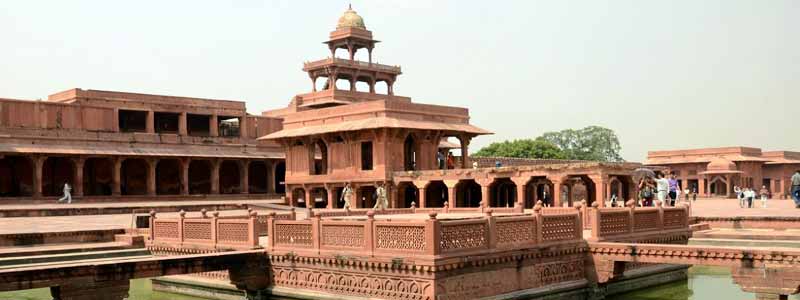
Fatehpur Sikri: To Celebrate Victory
Under the orders of the great Mughal Emperor Akbar, the royal city at Fatehpur Sikri, located 26 miles west of Agra, Uttar Pradesh, was built. Akbar built a magnificent city on the ridge of Sikri in honour of Saint Shaikh Salim Chisti. He ordered buildings to be constructed for his own use in 1571 and requested the noblemen to build houses for themselves.
Much of the work was completed within a year and a well-planned administrative, residential and religious project was completed within the next several years buildings came into existence.
Maybe among the first buildings to appear was the Jami Mosque. As the date of its completion, its epigraph gives AH 979 (A.D. 1571-72). Some five years later, Buland-Darwaza was added. The tomb of Shaikh Salim Chishti, Naubat-or Naqqar Khana (drum-house), Taksal (mint), Karkhanas (royal workshop), Khazana (treasury), Hakim’s quarters, Diwan-i-Am (public audience hall) are among other significant buildings, house of Maryam also called Sunahra Makan (Golden House), palace of Jodh Bai, Birbal’s house, etc.
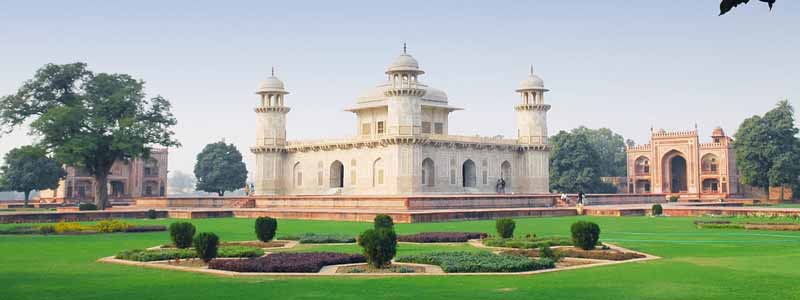
Itmad-Ud-Daulah’s Tomb: Famous Mausoleum
Mirza Ghias Beg, the father of the Mughal empress Nur Jahan, is devoted to this magnificent marble tomb. During his time at the Mughal court, he was given the title of Itimad-ud-Daulah (pillar of the state). In his memory, the empress is thought to have ordered the building of the mausoleum between 1622 and 1628 AD.
The storey says that when she gave birth to a child, Mirza Ghias Beg was a poor Persian merchant who was on his way to India with his wife. The parents wanted to leave the child because the family was stricken with poverty, but were finally persuaded to return to her after hearing her desperate cries. She was a bringer of good fortune to her kin, as it turned out, and they soon found a caravan that brought them to Emperor Akbar ‘s court. Beg rose to become a minister in the Mughal palace, as well as a trusted treasurer, as the years passed. Even after Akbar ‘s death, he continued to rise in court under the rule of Emperor Jehangir, who conferred the title of Itimad-ud-Daulah on him and eventually married his daughter.
The building, which is situated on the banks of the Yamuna River, exhibits clear Persian architectural influences and is entirely constructed using white marble with semi-precious stones. Local lore suggests that many consider this building a reference to the Taj Mahal. This is why it’s referred to as ‘Baby Taj’ occasionally. As compared to the red sandstone mausoleums that preceded it in the area, the marble lattice screens, known as jaalis, lend it a softer, more delicate air. As well as the first tomb to be built on the banks of the River Yamuna, this is also the first Mughal structure to have used pietra dura work. Chini-ka-Rauza and Mehtab Bagh are very close by, and within a couple of hours, a fast round up of all three spots can be completed.
Jama Masjid: Religious Site
Just across from Agra Fort, Jama Masjid is located. It is also popularly known as the Friday Mosque or Jami Masjid and is one of the well-known tourist places in Agra.
Emperor Shah Jahan designed Jama Masjid at the expense of Rs 5 lakhs for his favourite daughter Jahanara Begum ‘s wish, and it took 5 years to build and was completed in 1649 AD. It is one of India’s largest mosques. The structure of red sandstone was designed in a traditional Mughal style. It sits on an elevated plinth and is accessed by stairs. It consists of a spacious elevated courtyard, bordered to the north and south by arched porticos, with a fountain in its middle. An arched portico and a wide entrance had once bordered the eastern end, but those were demolished by the British in 1857 when the railway line to Agra was being constructed.
The prayer hall occupies the western end of the courtyard and is divided into five parts and topped by three wide domes and consists of a long rectangular structure. All the domes have inverted finials of lotus and kalash on the top. There are five archways linking the prayer hall to the courtyard, the central one of which is framed by a wide Iwan portico and a white marble facade with Persian calligraphy. Two small, slender minarets decorated in a zigzag pattern flanked the central archway once, but the minaret on the right side was lost. The top of the facade is a series of Chhatris.
There is a stunning mihrab and pulpit in white marble on the interior of the western wall. In praise of Jahanara and Shah Jahan, the Persian inscription in white marble incrusted with black stone is on the archway of the central portal. It is said that an octagonal (Muthamman) Chowk was constructed between the Delhi Gate and the Jama Masjid and was once surrounded by a market place called Tripolia. But, in 1871-73, it was later demolished in order to gain space to lay the railway tracks for the city.
Moti Masjid: Serene Ambiance
On the ground that slopes from east to west to the north of the Diwan-I-Am complex, stands the Moti Masjid or the Pearl Mosque, built between 1648-54. It is well-known for its pearly white marble interiors. The mosque’s exterior appears to be made of stone. At that moment, the colossal mosque was designed at an exponential expense of three lakhs of rupees and had a court lined with marble. It is very remarkable to see the marble tank positioned centrally in the court and the sundial made up of an octagonal marble pillar in one of its corners. On the northern, eastern and southern sides with twelve sided pillars and cusped arches, there are arcaded cloisters circling the courtyard while the prayer chamber is on its western side.
On the eastern side is the main entrance to the mosque and, thus, It is much larger and more majestic than the subsidiary gates that had arches and three square chhatris crowning them on the south and north sides. The main gateways were accessible by two staircases and had an exterior of red sandstone and an interior of marble. The prayer chamber has a seven-arched arcade. There are only three of its twenty-one bays which have vaulted soffits. The western wall is beautifully carved and inlaid with mihrab and six niches corresponding to the facade arches. There are four steps to the pulpit, unlike the normal three steps. On either side of the main prayer chamber, there are prayer chambers for women that have a marble latticework screen separating them from the main hall. There are three bulbous domes in this chamber crowning it. Over the parapet there are seven lovely square chhatris and an octagonal tower at each corner with a marble cupola on top.
Sikandra Fort: Timeless Architectural Beauty
Sikandra, which is just 13 km away. The last resting place of the Mughal Emperor Akbar is at Agra Fort. Akbar was one of the most secular royalties of his time and the greatest of the Mughal emperors. A great patron of the arts , literature, philosophy and science, he was the successor to a long tradition of Oriental refinement. A visit to the monument of Akbar opens before one, the completeness of the personality of Akbar as complete as that of Mumtaz Mahal’s Taj Mahal does. In the midst of a lush garden is Akbar ‘s massive, beautifully carved, red-ochre sandstone tomb. Akbar planned his own tomb himself and chose a fitting location for it. In 1613, Akbar ‘s son Jahangir finished the construction of this pyramidal tomb.
In the middle of a large garden, which is surrounded on all sides by high walls, stands the tomb. A monumental gateway is in the midst of each enclosed wall. On the traditional Charbhag plan, the entire garden is divided into four equal quarters. A high terrace or elevated path with a narrow shallow water channel running in the middle divides each quarter. Every terrace has a tank with fountains in the middle. To the crypt, which has five storeys and is in the form of a truncated pyramid, a wide paved causeway leads. The main tomb has a distinctive square style that is peculiar to all other Mughal buildings.
Jodha Bai Ka Rauza: Sophisticated Structure
Mariam-uz-Zamani Begum was an empress of the Mughal Empire, also known as Heer Kunwari, Hira Kunwari, Harka Bai or Jodha Bai. She was Emperor Akbar’s first chief Rajput wife (although before his marriage to Rajput Princess Heer Kunwari, Akbar already had two other chief Mughal wives and several other wives), and the mother of the next Mughal Emperor, Jahangir. She was also the grandmother of Shah Jahan, the next Mughal Emperor.
During the reign of the great Mughal, Emperor Akbar, and also during the reign of her son, Emperor Jahangir, Mariam-Uz-Zamani was referred to as the Queen Mother of Hindustan. She was the Hindu Mughal Empress who worked the longest. Her term lasted more than 43 years, from 6 February 1562 to 27 October 1605.
Her marriage to Akbar led to a gradual improvement in his social and religious policy. A very significant event in Mughal history was Akbar’s marriage to Rajkumari Heer Kunwari. In modern Indian historiography, she is widely regarded as exemplifying the tolerance of Akbar and the Mughal of religious differences and their egalitarian policies within an expanding multi-ethnic and multi-denominational empire.
The biggest of all the palaces, the palace of Jodha Bai, housed the queens of Akbar. Gujarat, Mandu and Gwalior architectural elements are combined with typical Islamic designs here. In Fatehpur Sikri, the blue-tiled roof is the only splash of colour.
Mehtab Bagh: Square-shaped Garden Complex
In the sequence of 11 parks along the Yamuna River in Agra, the crescent-shaped Mehtab Bagh is the last. Originally built in the early 1500s by the first Mughal emperor-Babur, the park’s history dates back to when there was no Taj Mahal. Later, this garden, however, went into disrepair. To shield Taj Mahal from the abrasion of sand, it was Shah Jahan who reconstructed the garden. This garden is situated in such a way that the perfect view of the Taj is provided. At present, one of the most beautiful places to visit in Agra is considered to be Mehtab Bagh, also known as ‘Moonlight Garden’. The past of this attractive garden is known to few, but it is very interesting; the width of the old garden designed by Babur was perfectly matched with that of Taj, and Shah Jahan therefore recognised it as an ideal place to admire the beauty of the Taj Mahal. The construction of this heritage destination in Agra was originally like a charbagh complex-a layout in the Persian style in which the garden is divided into four sections. There were white walkaways, well-ventilated pavilions, beautiful fruit trees and water fountains dividing the complex.
Most of these features were ruined by regular flooding in the early 1900s, and so the whole garden became a mound of sand. The Archaeological Survey of India (ASI) carried out an excavation at the garden site later in the year 1994. It was discovered in this excavation that Shah Jahan decided to build the Taj Mahal replica as his resting place on this very ground was nothing but a myth. The charbagh complex buried under the sand was actually discovered by this excavation. Every significant feature of this famous tourist attraction in Agra has now been restored to its original shape. To bring back the old grandeur of this striking garden, a variety of plants such as citrus, hibiscus and guava have also been planted. Mehtab Bagh is also an excellent place to enjoy the wonderful view of the sunset.
Chini Ka Rauza: Picturesque Site
Chini-ka-Rauza is thought to be the first structure to have been extensively embellished in India using glazed porcelain tiles, and is considered by many to be an significant landmark in Indo-Persian architecture. It is the mausoleum of the Prime Minister of the Mughal Emperor Shah Jahan, Afzal Khan Aalmi, who was also known as Shirazi, Maula Shukrullah. The mausoleum was built in Etmadpur in 1635 and is just a kilometre from Itmad-ud-Daulah ‘s tomb. Set amid lush gardens, the monument is renowned for its blue glazed tiles. These tiles, suspected to have been brought from China, were produced using porcelain. At the time, they were called ‘chini mitti’ (Chinese clay). While some of these are partly intact on the façade of the mausoleum, the interiors are reasonably well preserved and feature floral designs that are peculiar to a distinctive Persian style of art that eventually found a home in Agra.
The most striking feature of the structure is said to have been the tomb, which is now in ruins. Originally, it was round, very similar to the style of Afghani tombs.

